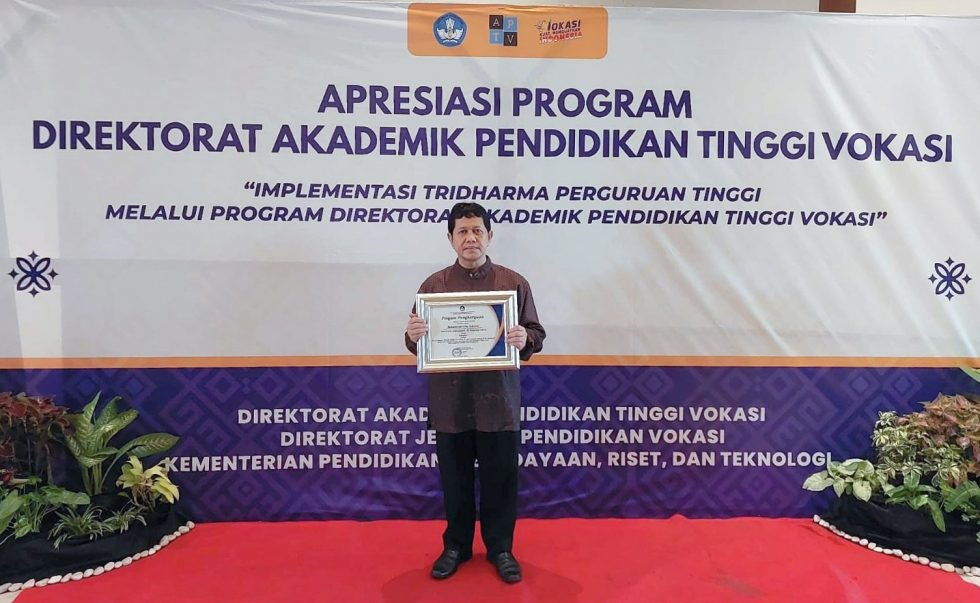Industrial Chemical Engineering Technology (TRKI) Undip Vocational lecturer, Mohamad Endy Yulianto, has once again achieved an Intellectual Property (KI) achievement from the Academic Directorate of Vocational Higher Education. The Ministry of Education, Culture, Research, and Technology Appreciation Event was attended by all tertiary institutions under Directorate General of Vocational Education (DIKSI), with the theme Implementation of the Three Pillars of Higher Education at the Sahid Jaya Hotel & Convention Yogyakarta recently. The head of directorate general of vocational education, Dr. Kiki Yuliati gave instructions that the program award was given for the dedication and contribution to lecturers’ performance achievements related to the implementation of the Tridharma of Higher Education. APTV Director Beny Bandanadjaja added that to motivate and encourage vocational universities by improving the quality of education. including the achievement of Intellectual Property which is the output of research and community service.
Endy conveyed downstream research starting with the green tea industry PPTK Gambung and PT. Rumpun Sari Medini was funded by RISPRO LPDP with the study “Development of a Competitive Green Tea Super Mini Plant through an Inactivation Process using a Mechanically Dispersed-Rotary Steamer”. The innovation of this research is increasing the levels of very attractive green tea catechins, so that the true efficacy of green tea will be very real in conquering deadly diseases. This research with TKT (Technology Readiness Level) 7–9 resulted in patent output, industrial steamer-cooler TTG, business plan documents, SOPs, market studies, and feasibility studies (FS). Patent granted no. IDS000007201 entitled “Enzymatic Inactivation Process for Making Green Tea using a Cylindrical Dispersing Steamer” and no. P00202002255 with the invention “Mechanically Dispersed-Rotary Steamer Integrated Cooling Tool for the Enzymatic Inactivation Process which was implemented in the Green Tea industry PPTK Gambung” said Endy, the inventor of 22 patent granted. “The research was motivated by listening to the world tea market which is overshadowed by symptoms of oversupply and production costs tend to increase, requiring tea producers to increase competitiveness and added value. In fact, environmental problems have contributed to the development of a new market segment for tea products, namely consumers who want environmentally friendly and healthy products. Even though tea is the most popular drink after water, it is consumed every day by millions of people around the world. “The health aspect which has also been conveyed sharply in recent years is in line with people’s tendency to consume substitute foods or drinks as a balance to a diet rich in fat and cholesterol,” explained Endy.
Endy, who has published 65 reputable journals indexed by Scopus, explains that green tea, which contains polyphenols such as: catechin, epicatechin, epigallo catechin, epicatechin gallate, epigallo catechin gallate and gallic acid, is stated to have anti-cancer activity, maintains heart health, is an antioxidant, anti-microbial, prolongs menopause, prevents cardiovascular disease, obesity and other degenerative diseases. However, green tea processing in Indonesia generally has a catechin content of ± 10.81% dry weight. The catechin content of green tea is relatively low, because some of it undergoes catechin oxidation, thermal degradation, catechin epimerization and in principle this is done through stages: panning, rolling, drying, sorting and packing. However, the stage that most determines the quality of green tea is the enzymatic inactivation process in the cytoplasm of the tea leaves. “So far, the method for inactivating the enzymes polyphenol oxidase and hydroperoxides for green tea production in Indonesia has been made using quite large energy requirements, namely 6,097 kJl/kg of tea or equivalent to the fuel requirement of 0.12 liters of IDO/kg of dry tea. “The basic weaknesses of the panning method are: heat penetration is unable to completely inactivate the enzyme, catechins are thermally degraded, and the tea produces a blackish color due to the degradation of chlorophyll into pheophytin,” said Endy.
Endy explained that the results of downstream research with the Dr.Eng Team Vita Paramita, S.T., M.M., M.Eng; Prof. Dr. Eflita Yohana; Dr. Indah Hartati; Dr. Dadan Rohdiana; and Didik Ariwibowo, S.T., M.T. through enzymatic inactivation technology using a mechanically dispersed rotary steamer process, it can reduce energy consumption and increase productivity up to IDR 1,620/kg of green tea. Commercial research results were also able to increase catechin levels from ± 10.81% (Panning) to ± 17.81% dry weight. This high level of catechin is actually very efficacious in fighting various deadly diseases. Hopefully in the future the entire green tea industry will apply Steaming technology which has been proven to be good, so that productivity and quality (catechins) increase and are healthier. “The research team hopes that the results of commercial research can be useful for the green tea industry, the pharmaceutical industry as a raw material for catechin preparation, tea planters and the society who consume the green tea as functional food which popular in nowdays” Endy said.


Recent Comments